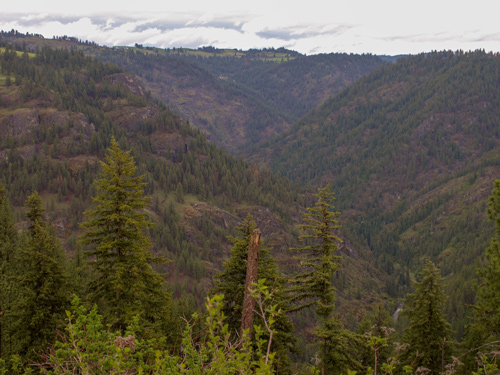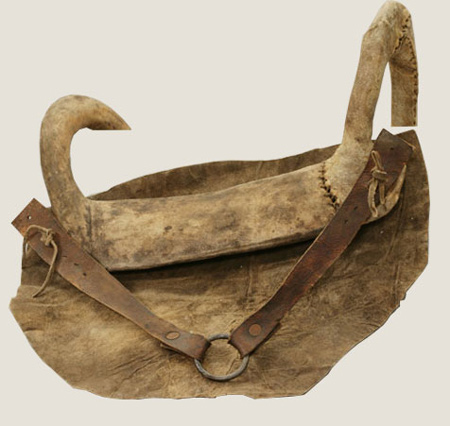The captains treat baby Jean Baptiste‘s high fever and swollen neck. Otherwise, the day is fair at Long Camp, and workers dry wet items. Two Nez Perce men report that salmon are running in the Snake (Lewis’s) River. Lewis describes Nez Perce saddles and says his horse is in poor health.
Drying Everything
by Yellowstone Public Radio[1]Originally aired weekdays by Yellowstone Public Radio during the Bicentennial observance of 2003-2006. Narrated by Hal Hansen. Scripts by Whit Hansen and Ed Jacobson. Produced by Leni Holliman. © … Continue reading
Clearwater River Canyon
View southeast
© 2009 May 3 by Kristopher K. Townsend. Permission to use granted under the Creative Commons Attribution-Share Alike 4.0 International license.
Hemmed in by Cliffs
we sent Sergt. Pryor down to the entrance of Collins Creek to examine the country and look out for a good position for an encampment on the river below that Creek . . . . Drewyer who has been at the place informs us that it is about 10 ms. and that there is no situation on the river for some distance below this creek which can possibly answer our purposes.—
—Meriwether Lewis
Baby Charbonneau’s Swollen Neck
Charbono’s Child [Jean Baptiste Charbonneau] is very ill this evening; he is cuting teeth, and for several days past has had a violent lax, which having suddonly stoped he was attacked with a high fever and his neck and throat are much swolen this evening. we gave him a doze of creem of tartar and flour of sulpher and applyed a poltice of boiled onions to his neck as warm as he could well bear it.
—Meriwether Lewis
Snake River Salmon Arrive
these [Nez Perce] indians also informed us that there were at this time a great number of salmon at no great distance from hence in Lewis’s river which had just arrived and were very fat and fine, they said it would be some yet before they would ascend this river as high as this place.
—Meriwether Lewis
Lewis’s Wounded Horse
my horse which was castrated the day before yesterday wounded his thigh on the iner side with the rope by which he was confined that evening and is now so much swolen with the wound the castraiting and the collection of vermen that he cannot walk, in short he is the most wretched specticle; I had his wounds clensed of the vermen by washing them well with a strong decoction of the bark of the roots & leaves of elder but think the chances are against his recovery.
—Meriwether Lewis
Nez Perce Saddles
The frames of their saddles are made of wood nicely jointed, and then covered with raw skins, which when they become dry, bind every part tight, and keep the joints in their places. The saddles rise very high before and behind, in the manner of the saddles of the Spaniards, from whom they no doubt received the form; and also obtained their breed of horses. When the Indians are going to mount they throw their buffaloe robes over the saddles and ride on them, as the saddles would otherwise be too hard.
—Patrick Gass
Weather Diary
State of the Weather at rise
Wind at rise
State of the Weather at 4 P.M. Wind at 4 P.M. State of the Kooskooskee fair S E fair S E fallen 2 in. air colder this morning than usual white frost tho’ no ice. since our arrival in this neighbourhood on the 7th inst. all the rains noted in the diary of the weather were snows on the plain and in some instances it snowed on the plains when only a small mist was perseptable in the bottoms at our camps. (The high plains are about 800 feet higher than the Small bottoms on the river and creeks.)
—Meriwether Lewis and William Clark[2]To assist the reader of this web page, the date column is not presented, the river columns have been merged, and some abbreviations have been spelled out.
Notes
| ↑1 | Originally aired weekdays by Yellowstone Public Radio during the Bicentennial observance of 2003-2006. Narrated by Hal Hansen. Scripts by Whit Hansen and Ed Jacobson. Produced by Leni Holliman. © 2003 by Yellowstone Public Radio. |
|---|---|
| ↑2 | To assist the reader of this web page, the date column is not presented, the river columns have been merged, and some abbreviations have been spelled out. |


